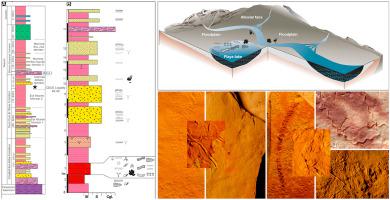当前位置:
X-MOL 学术
›
J. Afr. Earth Sci.
›
论文详情
Our official English website, www.x-mol.net, welcomes your feedback! (Note: you will need to create a separate account there.)
Late Triassic ichnoassemblage from a playa-lake system of the Coastal Meseta, Morocco: Palaeoenvironmental and palaeoecological implications
Journal of African Earth Sciences ( IF 2.3 ) Pub Date : 2020-12-01 , DOI: 10.1016/j.jafrearsci.2020.103995 Abdelkbir Hminna , Abdelouahed Lagnaoui , Tariq Zouheir , Hafid Saber , Joerg W. Schneider
Journal of African Earth Sciences ( IF 2.3 ) Pub Date : 2020-12-01 , DOI: 10.1016/j.jafrearsci.2020.103995 Abdelkbir Hminna , Abdelouahed Lagnaoui , Tariq Zouheir , Hafid Saber , Joerg W. Schneider

|
Abstract Here we present the first comprehensive ichnotaxonomic analysis of a Late Triassic playa system from the Sidi Said Maachou Basin, Coastal Meseta (Western Meseta, Morocco). The Late Triassic deposits consist of sediments deposited in various nonmarine environments dominated by dry red-bed facies. These deposits yielded, so far, an ichnoassemblage consisting of the invertebrate ichnogenera Cochlichnus, Cruziana, Diplichnites, Rusophycus, Palaeophycus, and Taenidium associated with the tetrapod tracks Brachychirotherium and Rhynchosauroides. These invertebrate and vertebrate trace fossils are preserved in concave epirelief and convex hyporelief on upper and lower surfaces of laminated mudstones and fine-grained sandstones. The invertebrate ichnofossils were probably made subaqueously and indicate different behaviours of the tracemakers: walking (cursichnium, Acripes), resting (cubichnium, Rusophycus) and combined locomotion-feeding or plowing (pascichnium, Cruziana). Additionally, many other fossils are collected from the same formation, including plant impressions, rhizoliths and fish scales. The invertebrate ichnoassemblage described herein is referred to the Scoyenia ichnofacies, which indicates opportunistic behaviours in temporarily or periodically inundated nonmarine environments, such as playa systems, floodplains and lake margins. The invertebrate ichnoassemblage reported here is the first well documented from the Sidi Said Maachou Basin and the Late Triassic of Morocco in general. The strata have a high potential to yield other ichnoassemblages, therefore further exploration is needed.
中文翻译:

来自摩洛哥梅塞塔海岸海滩系统的晚三叠世地层组合:古环境和古生态学意义
摘要 在这里,我们首次对梅塞塔海岸(摩洛哥西梅塞塔)的 Sidi Said Maachou 盆地晚三叠世海滩系统进行了首次综合鱼类分类学分析。晚三叠世沉积物由沉积在以干燥红层相为主的各种非海相环境中的沉积物组成。到目前为止,这些沉积物产生了一个由无脊椎动物 ichnogenera Cochlichnus、Cruziana、Diplichnites、Rusophycus、Palaeophycus 和 Taenidium 组成的鱼群组合,与四足动物的足迹 Brachychirotherium 和 Rhynchosauroides 相关。这些无脊椎动物和脊椎动物痕迹化石保存在层状泥岩和细粒砂岩的上、下表面的凹面浮雕和凸面浮雕中。无脊椎动物的鱼化石可能是在水下制成的,并表明示踪者的不同行为:行走(cursichnium,Acripes),休息(cubichnium,Rusophycus)和联合运动喂养或耕作(pascichnium,Cruziana)。此外,从同一地层收集了许多其他化石,包括植物印记、根石和鱼鳞。此处描述的无脊椎动物鱼类组合被称为 Scoyenia ichnofacies,它表示在临时或周期性淹没的非海洋环境中的机会主义行为,例如海滩系统、洪泛区和湖泊边缘。此处报道的无脊椎动物鱼类组合是西迪赛义德马丘盆地和摩洛哥晚三叠世的第一个有据可查的。该地层具有产生其他地层组合的巨大潜力,因此需要进一步勘探。Rusophycus)和联合运动喂养或耕作(pascichnium,Cruziana)。此外,从同一地层收集了许多其他化石,包括植物印记、根石和鱼鳞。此处描述的无脊椎动物鱼类组合被称为 Scoyenia ichnofacies,它表示在临时或周期性淹没的非海洋环境中的机会主义行为,例如海滩系统、洪泛区和湖泊边缘。这里报道的无脊椎动物鱼群是第一个在西迪赛义德马丘盆地和摩洛哥晚三叠世有充分记录的。该地层具有产生其他地层组合的巨大潜力,因此需要进一步勘探。Rusophycus)和联合运动喂养或耕作(pascichnium,Cruziana)。此外,从同一地层收集了许多其他化石,包括植物印记、根石和鱼鳞。此处描述的无脊椎动物鱼类组合被称为 Scoyenia ichnofacies,它表示在临时或周期性淹没的非海洋环境中的机会主义行为,例如海滩系统、洪泛区和湖泊边缘。这里报道的无脊椎动物鱼群是第一个在西迪赛义德马丘盆地和摩洛哥晚三叠世有充分记录的。该地层具有产生其他地层组合的巨大潜力,因此需要进一步勘探。包括植物印象、根石和鱼鳞。本文所述的无脊椎动物鱼类组合被称为 Scoyenia ichnofacies,它表示在临时或周期性淹没的非海洋环境中的机会主义行为,例如海滩系统、洪泛区和湖泊边缘。这里报道的无脊椎动物鱼群是第一个在西迪赛义德马丘盆地和摩洛哥晚三叠世有充分记录的。该地层具有产生其他地层组合的巨大潜力,因此需要进一步勘探。包括植物印象、根石和鱼鳞。此处描述的无脊椎动物鱼类组合被称为 Scoyenia ichnofacies,它表示在临时或周期性淹没的非海洋环境中的机会主义行为,例如海滩系统、洪泛区和湖泊边缘。此处报道的无脊椎动物鱼类组合是西迪赛义德马丘盆地和摩洛哥晚三叠世的第一个有据可查的。该地层具有产生其他地层组合的巨大潜力,因此需要进一步勘探。这里报道的无脊椎动物鱼群是第一个在西迪赛义德马丘盆地和摩洛哥晚三叠世有充分记录的。该地层具有产生其他地层组合的巨大潜力,因此需要进一步勘探。这里报道的无脊椎动物鱼群是第一个在西迪赛义德马丘盆地和摩洛哥晚三叠世有充分记录的。该地层具有产生其他地层组合的巨大潜力,因此需要进一步勘探。
更新日期:2020-12-01
中文翻译:

来自摩洛哥梅塞塔海岸海滩系统的晚三叠世地层组合:古环境和古生态学意义
摘要 在这里,我们首次对梅塞塔海岸(摩洛哥西梅塞塔)的 Sidi Said Maachou 盆地晚三叠世海滩系统进行了首次综合鱼类分类学分析。晚三叠世沉积物由沉积在以干燥红层相为主的各种非海相环境中的沉积物组成。到目前为止,这些沉积物产生了一个由无脊椎动物 ichnogenera Cochlichnus、Cruziana、Diplichnites、Rusophycus、Palaeophycus 和 Taenidium 组成的鱼群组合,与四足动物的足迹 Brachychirotherium 和 Rhynchosauroides 相关。这些无脊椎动物和脊椎动物痕迹化石保存在层状泥岩和细粒砂岩的上、下表面的凹面浮雕和凸面浮雕中。无脊椎动物的鱼化石可能是在水下制成的,并表明示踪者的不同行为:行走(cursichnium,Acripes),休息(cubichnium,Rusophycus)和联合运动喂养或耕作(pascichnium,Cruziana)。此外,从同一地层收集了许多其他化石,包括植物印记、根石和鱼鳞。此处描述的无脊椎动物鱼类组合被称为 Scoyenia ichnofacies,它表示在临时或周期性淹没的非海洋环境中的机会主义行为,例如海滩系统、洪泛区和湖泊边缘。此处报道的无脊椎动物鱼类组合是西迪赛义德马丘盆地和摩洛哥晚三叠世的第一个有据可查的。该地层具有产生其他地层组合的巨大潜力,因此需要进一步勘探。Rusophycus)和联合运动喂养或耕作(pascichnium,Cruziana)。此外,从同一地层收集了许多其他化石,包括植物印记、根石和鱼鳞。此处描述的无脊椎动物鱼类组合被称为 Scoyenia ichnofacies,它表示在临时或周期性淹没的非海洋环境中的机会主义行为,例如海滩系统、洪泛区和湖泊边缘。这里报道的无脊椎动物鱼群是第一个在西迪赛义德马丘盆地和摩洛哥晚三叠世有充分记录的。该地层具有产生其他地层组合的巨大潜力,因此需要进一步勘探。Rusophycus)和联合运动喂养或耕作(pascichnium,Cruziana)。此外,从同一地层收集了许多其他化石,包括植物印记、根石和鱼鳞。此处描述的无脊椎动物鱼类组合被称为 Scoyenia ichnofacies,它表示在临时或周期性淹没的非海洋环境中的机会主义行为,例如海滩系统、洪泛区和湖泊边缘。这里报道的无脊椎动物鱼群是第一个在西迪赛义德马丘盆地和摩洛哥晚三叠世有充分记录的。该地层具有产生其他地层组合的巨大潜力,因此需要进一步勘探。包括植物印象、根石和鱼鳞。本文所述的无脊椎动物鱼类组合被称为 Scoyenia ichnofacies,它表示在临时或周期性淹没的非海洋环境中的机会主义行为,例如海滩系统、洪泛区和湖泊边缘。这里报道的无脊椎动物鱼群是第一个在西迪赛义德马丘盆地和摩洛哥晚三叠世有充分记录的。该地层具有产生其他地层组合的巨大潜力,因此需要进一步勘探。包括植物印象、根石和鱼鳞。此处描述的无脊椎动物鱼类组合被称为 Scoyenia ichnofacies,它表示在临时或周期性淹没的非海洋环境中的机会主义行为,例如海滩系统、洪泛区和湖泊边缘。此处报道的无脊椎动物鱼类组合是西迪赛义德马丘盆地和摩洛哥晚三叠世的第一个有据可查的。该地层具有产生其他地层组合的巨大潜力,因此需要进一步勘探。这里报道的无脊椎动物鱼群是第一个在西迪赛义德马丘盆地和摩洛哥晚三叠世有充分记录的。该地层具有产生其他地层组合的巨大潜力,因此需要进一步勘探。这里报道的无脊椎动物鱼群是第一个在西迪赛义德马丘盆地和摩洛哥晚三叠世有充分记录的。该地层具有产生其他地层组合的巨大潜力,因此需要进一步勘探。



























 京公网安备 11010802027423号
京公网安备 11010802027423号